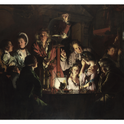Bill Woodrow’s “Electric Fire with Yellow Fish” (1981) paved the way for Hirst and Lucas
Modern British SculptureRoyal Academy, until 7th April
You’ve got to admire the chutzpah. The list of omissions in the Royal Academy’s show “Modern British Sculpture” was staggering. I had to go round it four times to make sure the names I missed weren’t really there. No Anish Kapoor, who had a solo exhibition at the RA in 2009; no Rachel Whiteread, who’s done the Fourth Plinth and Turbine Hall; no Tracey Emin, whose bed and tent are classics of our time; and no Antony Gormley, creator of The Angel of the North, Britain’s most famous public sculpture after Nelson’s column. There was nothing by the Chapman brothers, Richard Deacon or Elizabeth Frink; I’ll admit I missed the Richard Wentworth, but it was only a video.
The curatorial decisions were so bold that the usual reasons given for leaving stuff out—that sculpture is so big, there’s so much of it, that difficult choices have to be made—just don’t wash. Instead, this is something virtually unheard-of in today’s art world: an attempt by the curators—artist Keith Wilson and Penelope Curtis, the new director of Tate Britain—to tell us what the important stuff is and, by implication of omission, what the crap is too.
Newspaper critics have fumed about the gaping holes in what was meant to be a “blockbuster” exhibition. But they could have applauded some of the absences instead, such as Marc Quinn, whose one-liners of frozen flowers and “classical” marbles of people with disabilities are widely considered some of the most supercilious artworks of our age. Or Whiteread, whose entire career is built on versions of one work—Bruce Nauman’s A Cast of the Space under My Chair (1965-68). They might have welcomed the omission of Gormley, whose self-referential casts of his own body provoke sneers from every curator I have ever met.
Here at last was a major exhibition that paid no heed to the art market, media favourites or popular hits. The first room was amazing, with early British modernist sculptures set side-by-side with work from ancient civilisations, some of it as old as 2,000BC. The curators have included little-known but rather brilliant artists like 1960s conceptualist Keith Arnatt and contemporary artist Gary Webb, whose garish work usually looks like it was inspired by the interior of an 1980s nightclub.
Yet, for its merits, the show failed to tell us the good news. For most of the past century, we Brits have been self-deprecating about our visual arts, including sculpture. After the success of Damien Hirst, Sarah Lucas and Britart in the 1990s, there has been justification for a reassessment.
This exhibition could have been organised along dramatic chapters of success. It could have told us how Henry Moore’s organic abstraction—the cuddly Picasso look—became one of the world’s biggest art brands in the 1950s and 1960s, single-handedly rivalling all the CIA-backed abstract expressionists, as commissions poured in to fill German and American town squares with his large maternal blobs. They could have talked about how we, a nation of ramblers, invented the genre of the “walk-as-sculpture” in the 1970s with Richard Long and Hamish Fulton, or pointed out how Brits like Tony Cragg pioneered “ecological” art with sculpture from recycled junk. Or it could have shown how Bill Woodrow and Richard Wentworth’s readymade-based sculptures (represented in this show by Woodrow’s witty fish in an electric heater, below) paved the way for Hirst and Lucas.
The story of British modern sculpture has intriguing twin strands, which this exhibition’s inclusions and omissions imply. On the one hand there are artist-celebs like Moore, Gormley, Kapoor, Long and Hirst who achieve unparallelled fame with romanticised and commercialised adaptations of global art trends. On the other hand, there are the obscure or underrated artists such as Stuart Brisley, Keith Arnatt and John Latham, who have spent much of their time teaching in art schools, wearing corduroys and making uncompromising conceptual art.
Only now, post-Britart, can we see how influential this second strand has been. It would have been a good time for a show which set these groups against each other.
Modern British SculptureRoyal Academy, until 7th April
You’ve got to admire the chutzpah. The list of omissions in the Royal Academy’s show “Modern British Sculpture” was staggering. I had to go round it four times to make sure the names I missed weren’t really there. No Anish Kapoor, who had a solo exhibition at the RA in 2009; no Rachel Whiteread, who’s done the Fourth Plinth and Turbine Hall; no Tracey Emin, whose bed and tent are classics of our time; and no Antony Gormley, creator of The Angel of the North, Britain’s most famous public sculpture after Nelson’s column. There was nothing by the Chapman brothers, Richard Deacon or Elizabeth Frink; I’ll admit I missed the Richard Wentworth, but it was only a video.
The curatorial decisions were so bold that the usual reasons given for leaving stuff out—that sculpture is so big, there’s so much of it, that difficult choices have to be made—just don’t wash. Instead, this is something virtually unheard-of in today’s art world: an attempt by the curators—artist Keith Wilson and Penelope Curtis, the new director of Tate Britain—to tell us what the important stuff is and, by implication of omission, what the crap is too.
Newspaper critics have fumed about the gaping holes in what was meant to be a “blockbuster” exhibition. But they could have applauded some of the absences instead, such as Marc Quinn, whose one-liners of frozen flowers and “classical” marbles of people with disabilities are widely considered some of the most supercilious artworks of our age. Or Whiteread, whose entire career is built on versions of one work—Bruce Nauman’s A Cast of the Space under My Chair (1965-68). They might have welcomed the omission of Gormley, whose self-referential casts of his own body provoke sneers from every curator I have ever met.
Here at last was a major exhibition that paid no heed to the art market, media favourites or popular hits. The first room was amazing, with early British modernist sculptures set side-by-side with work from ancient civilisations, some of it as old as 2,000BC. The curators have included little-known but rather brilliant artists like 1960s conceptualist Keith Arnatt and contemporary artist Gary Webb, whose garish work usually looks like it was inspired by the interior of an 1980s nightclub.
Yet, for its merits, the show failed to tell us the good news. For most of the past century, we Brits have been self-deprecating about our visual arts, including sculpture. After the success of Damien Hirst, Sarah Lucas and Britart in the 1990s, there has been justification for a reassessment.
This exhibition could have been organised along dramatic chapters of success. It could have told us how Henry Moore’s organic abstraction—the cuddly Picasso look—became one of the world’s biggest art brands in the 1950s and 1960s, single-handedly rivalling all the CIA-backed abstract expressionists, as commissions poured in to fill German and American town squares with his large maternal blobs. They could have talked about how we, a nation of ramblers, invented the genre of the “walk-as-sculpture” in the 1970s with Richard Long and Hamish Fulton, or pointed out how Brits like Tony Cragg pioneered “ecological” art with sculpture from recycled junk. Or it could have shown how Bill Woodrow and Richard Wentworth’s readymade-based sculptures (represented in this show by Woodrow’s witty fish in an electric heater, below) paved the way for Hirst and Lucas.
The story of British modern sculpture has intriguing twin strands, which this exhibition’s inclusions and omissions imply. On the one hand there are artist-celebs like Moore, Gormley, Kapoor, Long and Hirst who achieve unparallelled fame with romanticised and commercialised adaptations of global art trends. On the other hand, there are the obscure or underrated artists such as Stuart Brisley, Keith Arnatt and John Latham, who have spent much of their time teaching in art schools, wearing corduroys and making uncompromising conceptual art.
Only now, post-Britart, can we see how influential this second strand has been. It would have been a good time for a show which set these groups against each other.













